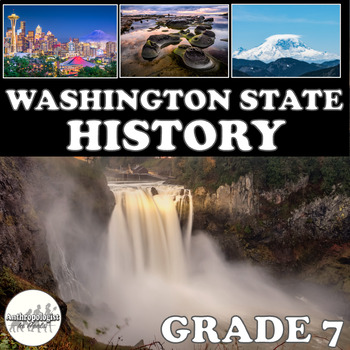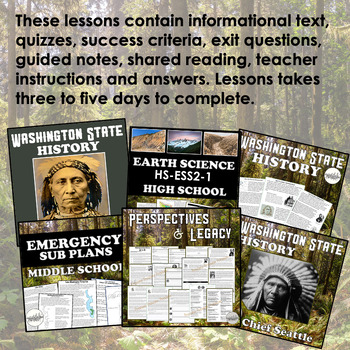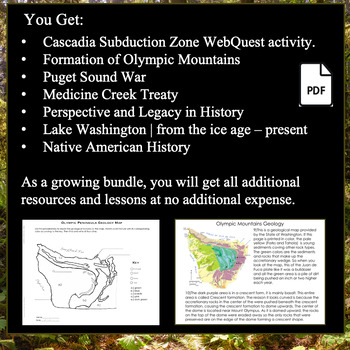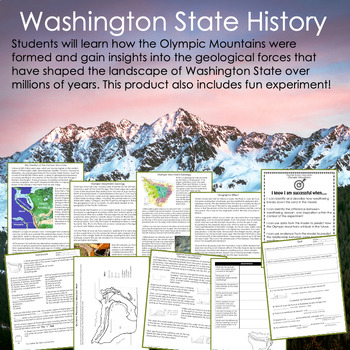Washington State History Bundle | Grade 7 ✩₊̣̇. ੈ♡˳ ✧
- Zip
Products in this Bundle (7)
showing 1-5 of 7 products
Description
Welcome to Washington State History Bundle - comprehensive lessons from Native American history to geological phenomena, Washington State cultural landmarks, and key figures. This bundle offers a comprehensive exploration of Washington's heritage. Students will learn about the Cascadia Subduction Zone, Formation of Olympic Mountains and they will even learn about how Lake Washington was formed during the last ice age!
✏️ Student Profile
Ideal students will be grade 7 if they are taking Washington State History
If this lesson is used for science, students would be grade 9-10. ♡ ♡ ♡
Teacher Profile
Middle school teacher of social studies or science. If you just need a collection of emergency sub plans, this is your product! ☆ *¨☆
┊ ┊⋆。 ┊ ┊ ┊ ┊ ┊ ⋆。 ┊ ┊ ┊ ┊⋆。┊ ┊⋆。 ┊ ┊ ┊ ┊ ┊ ⋆。 ┊ ┊ ┊ ┊⋆。
Lesson Highlights:
- Explore the lives and legacies of Chief Seattle, Chief Joseph, Chief Leschi, Chief Quiemouth, and Governor Issac Stevens.
- Learn about pivotal events such as the Native American Removal Act, formation and cleanup of Lake Washington, and cultural activities on the lake.
- Discover the significance of floating bridges and key cities like Seattle, Renton, Bellevue, Kirkland, and Kenmore on a map.
- Gain insights into real tsunami risks at the Cascadia Subduction Zone and the geological processes behind the formation of the Olympic Mountains and the rain shadow phenomenon.
Comprehensive Resources:
- Engaging experiments, quizzes, guided notes, think-pair-share activities, and teacher instructions facilitate interactive learning experiences.
- Answer keys provided for easy grading and assessment.
- Growing bundle with upcoming lessons on iconic landmarks such as Mount Saint Helens, Mount Rainier, Mount Baker, and cultural phenomena like Starbucks, Boeing, grunge music, state stones, minerals, and trees.
┊ ┊⋆。 ┊ ┊ ┊ ┊ ┊ ⋆。 ┊ ┊ ┊ ┊⋆。┊ ┊⋆。 ┊ ┊ ┊ ┊ ┊ ⋆。 ┊ ┊ ┊ ┊⋆。
Designed for 7th-grade middle schoolers!
A Closer Look At Content:
- Layered Sediment Model Experiment: Unleash the curiosity of young minds as students embark on an immersive experiment exploring geological processes such as accretion and erosion. With our Layered Sediment Model lesson plan, students will craft mesmerizing models using colored sand, unraveling the mysteries of Washington's geological marvels.
- Plate Tectonics and Geology: Dive into the fascinating realm of plate tectonics and geology with four pages of informational text meticulously crafted to elucidate the intricacies of Washington's geological landscape. From the enigmatic Juan de Fuca Plate to the majestic Olympic Mountains, students will unravel the geological mysteries that shape the Evergreen State.
- Earthquake Preparedness: Equip students with vital knowledge about earthquake risks and tsunami hazards along the Juan de Fuca fault. Through engaging articles and guided notes, students will delve into topics such as Cascadia fault dynamics, earthquake frequency, and tsunami preparedness, empowering them to navigate the seismic landscapes of Washington State with confidence.
Comprehensive Resources:
- Detailed teacher instructions facilitate seamless lesson organization over three days, ensuring optimal engagement and learning outcomes.
- Engaging homework assignments and quizzes reinforce learning objectives and assess student comprehension.
- Geology coloring pages and maps offer interactive learning experiences, stimulating student creativity and exploration.
- Accessible in both print and digital formats, our resources cater to diverse learning needs and preferences.
Standards-Aligned Education:
Our bundle aligns with prominent educational standards, including ESS3-3 and ESS2-2, fostering academic excellence while promoting holistic learning experiences. Whether used as emergency sub plans or integrated into existing curricula, our resources empower educators to deliver enriching educational experiences that resonate with students.
Teacher Notes:
- PDF resources are non-editable, ensuring consistency and reliability in educational delivery.
- Comprehensive answer keys facilitate seamless assessment and grading processes, saving educators valuable time and effort.
Washington State History Standards:
- WHST.7.5: Analyze the reasons specific individuals, including explorers, missionaries, and settlers, contributed to Washington state's cultural, social, and economic development.
- WHST.7.4: Analyze the geographic, political, economic, and cultural boundaries that defined the various native peoples in Washington State and their interactions with newcomers.
- WHST.7.10: Analyze complex and interacting factors that influenced the perspectives of people during different historical eras.
Science Standards:
- ESS3-3: Analyze and interpret data on natural hazards to forecast future catastrophic events and inform the development of technologies to mitigate their effects.
- ESS2-2: Construct an argument supported by evidence for how forces responsible for plate motion cause changes to the Earth's surface.
─────────────────
┊ ┊ ┊⋆。 ┊ ┊ ┊ ┊
┊ ⋆。 ┊ ┊ ┊ ┊⋆。┊ ༊*·˚
┊ ┊ ┊ ┊ ┊ ┊
┊ ‧₊ ༉ ┊ ˚✩ ┊ ๑՞.
┊ ₊˚.༄ ┊
✩₊̣̇. ੈ♡˳
✧.*ೃ༄
If this product works for you - so will these.....
Evolution and Extinct Animal Studies!
Marsupial Lion - Extinct Animal Study
Extinct Animal Informational Writing and Group Presentation
Evidence For Evolution | Tiktaalik Activity
The Fossil Record: Analyzing Patterns and Time Periods
Evolution and Speciation Activities ☆ Worksheet ☆ Population Genetics
Mass Extinctions Lesson | Mega-fauna | Printable & Digital
Evolution Bundle for Middle & High School Science
Hominid Evolution | Evolution of Bipedalism
✅ Look for the green star next to my store logo and click it to become a follower. You will receive Free Updates
How to get TPT credit to use on future purchases:
- Please go to your “My Purchases” page (you may need to login). Beside each purchase you'll see a Provide Feedback button. Simply click it and you will be taken to a page where you can give a quick rating and leave a short comment for the product.
- Each time you give feedback, TPT gives you feedback credits that you use to lower the cost of your future purchases. I value your feedback greatly as it helps me determine which products are most valuable for your classroom so I can create more for you.





